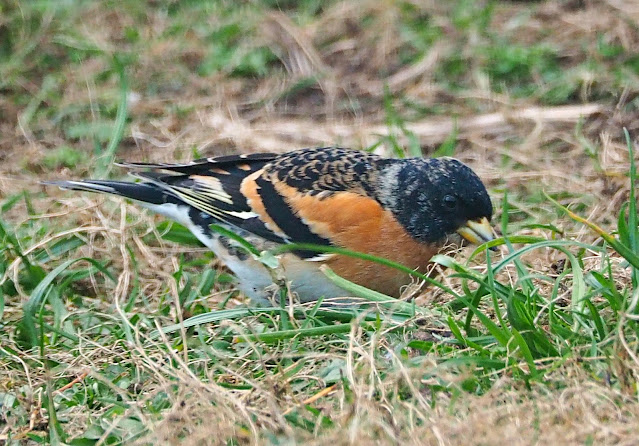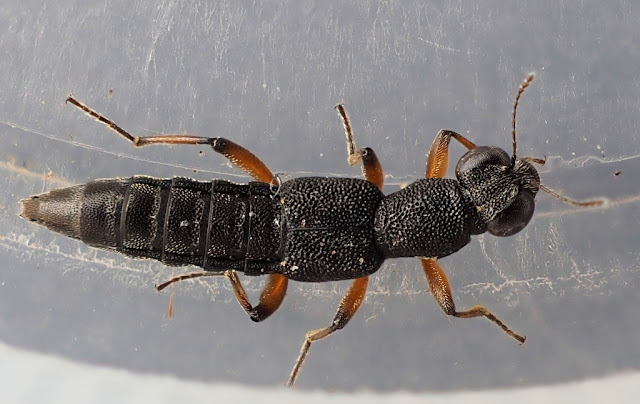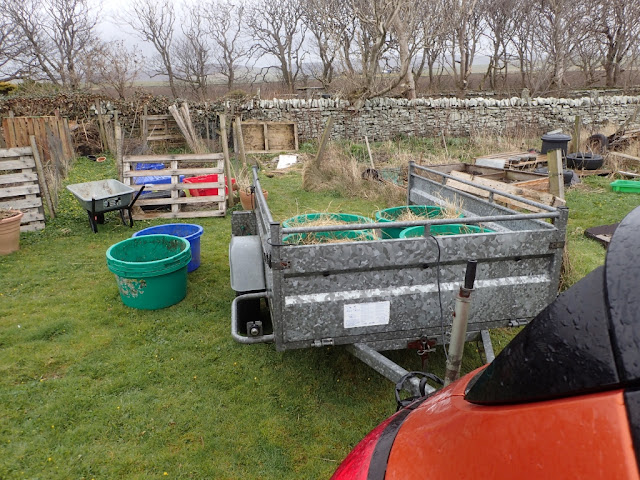The recent run of new birds for the home patch continues with the long expected Little Egret finally turning up on The Shunan. Not as I imagined was it wading and feeding in the shallows, instead it was half-way up a bank sheltering from a near-hoolie as winter returned. This is a species that must have been here before as I've seen them often on nearby Loch of Sabiston, but my connection has failed until now.
 |
A stunning image of the latest addition to the patch bird list.
|
Other birds this week have included a brief Greenshank, regular Pied Wags, a few Redwing and the last few Brambling hanging on, just two here today, they'll be gone soon. The worst bird news is that yesterday's 24 hours of rain has pushed up the water levels so most of everything on The Shunan has now shoved off and breeders like Redshank and Lapwing have likely had their nests flooded out. Perhaps the Coot built high enough. The next warm day should bring some Sand Martins or a Wheatear I expect. Watching on the coast today I saw my first Bonxie of the year heading northwards.
The lifers are not birds, unsurprisingly. They have included a seaweed, three lichens, two molluscs, an isopod, three Collembola, a fly, two beetles, a liverwort and a flowering plant. I'm still working on the ID of some of these, and in the case of the fly and one of the Collembola other folk are doing the hard graft, or will be once I send the specimens off.
First off, the fly is a Chironomid. Aaaarrrrggggghhhh, impossible, surely. Well, maybe and maybe not. The seashore books I use quite a bit are Hatcher and Trewella. Both books include some odds and ends, especially in the insect sections, and as I'm currently exploring the inter-tidal zone I've made a mental note of a few things, sometimes inadvertently. I went out last week, on a sunny, calm day, to look for the beetle Chrysolina latecincta, north of its known range. This involved a fair old tramp on two bits of coastline, and to no avail. On the way back from the second outing I wandered down onto the shore following the retreating tide. I mooched around and managed to identify a common seaweed that was new but didn't see much else until I noticed some flies scampering over the algae on the vertical faces of rocks well down the shore.
 |
Telmatogeton sp, possibly T. japonicus, a marine splash midge.
|
A look in the books when I got home and I found that the likliest candidate was Telmatogeton japonicus. This is an invasive species that originates from Japan. It lays it's eggs on the lower shore where the larvae develop, however, it will also lay its eggs on suitable man-made structures, like ships. First found in Europe in 1962 it appears its distribution has been expanding rapidly, especially since the 1980s. There are very few records on the NBN partly because of the difficulty of identifying it to species. There is a confusion species T. murrayi, and also a species from another genus. I made a few enquiries and today a specimen has been posted off to an expert, hopefully they will manage an ID. Or I might have to go and find, and collect some more.
During the same expedition I photographed a Collembola from under stones on the beach.
 |
Orchesella villosa, or maybe not.
|
I thought I knew what this was, however, after posting online the national expert on these got back to me and asked for specimens. Apparently, there is a possibility of a new species, a split, for the seashore version of this springtail. I headed out today, managed to catch a couple, took new photographs and was about to bottle them up when I managed to drop the tube. As these things are just a few millimetres long I wasn't going to find them again, so I'll have to go back and catch some more.
 |
Orchesella villosa, maybe, the lost specimen.
|
It's not far from home, just about the nearest seashore, so no hardship to go back again. I try to avoid taking specimens so annoying to have lost what I had.
The cold has meant the pitfall traps have been quiet, and I've certainly not attempted any mothing. However, I have been twitching, a plant. This is not unprecedented, in my youth there was quite a fad for birders to twitch orchids and I did twitch the Lady's Slipper many, many years ago. This twitch was not quite at that level of rarity. Indeed, to put it in birding terms, it was like twitching a Greenshank. Anyway, the gen was received and off I went to Binscarth Woods.
 |
Opposite-leaved Golden Saxifrage.
|
 |
The paired leaves are not cordate, ID feature.
|
Within a few centimetres of the plants I was photographing I found a liverwort I didn't know and a small beetle which was unfamiliar.
Now these should be identifiable surely? But actually the liverwort is a bit tricky and I'm going to need to phone a friend... BH! I think I know what it is but...
The beetle is even more awkward. The answer I've come to would make it the second Scottish record in the NBN. And the other record is hundreds of miles south. But it seems to key out correctly, I'm currently obtaining assistance (thanks MF). If it does turn out to be a second Scottish record I expect I'll need to send it to someone.
 |
Keteretes pusillus I think. Antennal segements 1 & 2 are an interesting shape and the claws don't have a basal hook. As the beast is 2.5mm long it can be appreciated that these details are somewhat challenging to see and evidence.
|
If it does turn out to be the Keteretes I'll be well chuffed.
I had to get the car checked for a slow puncture in Stromness. I lacked enthusiasm for searching for Danish Scurvy-grass, the only Orkney location, saved for another day, instead I went to Yesnaby. No sign of Chrysolina latecincta trundling around. So, I started turning stones over.
 |
Ligia oceanica.
|
I don't recall ever seeing this species before. There were plenty of Common Rough Woodlouse, hundreds. But then I found a sheltering Chrysolina latecincta.
 |
Chrysolina latecincta intermedia, sheltering from the cold.
|
Next, and most pleasingly I found this weevil.
 |
Otiorhynchus arcticus.
|
This weevil has fewer than 50 Scottish records in the NBN. There are a few from our west coast, however. Not a common beastie.
 |
Otiorhynchus arcticus.
|
I was well pleased to find this beastie, about the size of Chrysolina, so not a tiny weevil.
I might add the photos of the lichens etc to the end of this post later, running out of puff for now.




















































